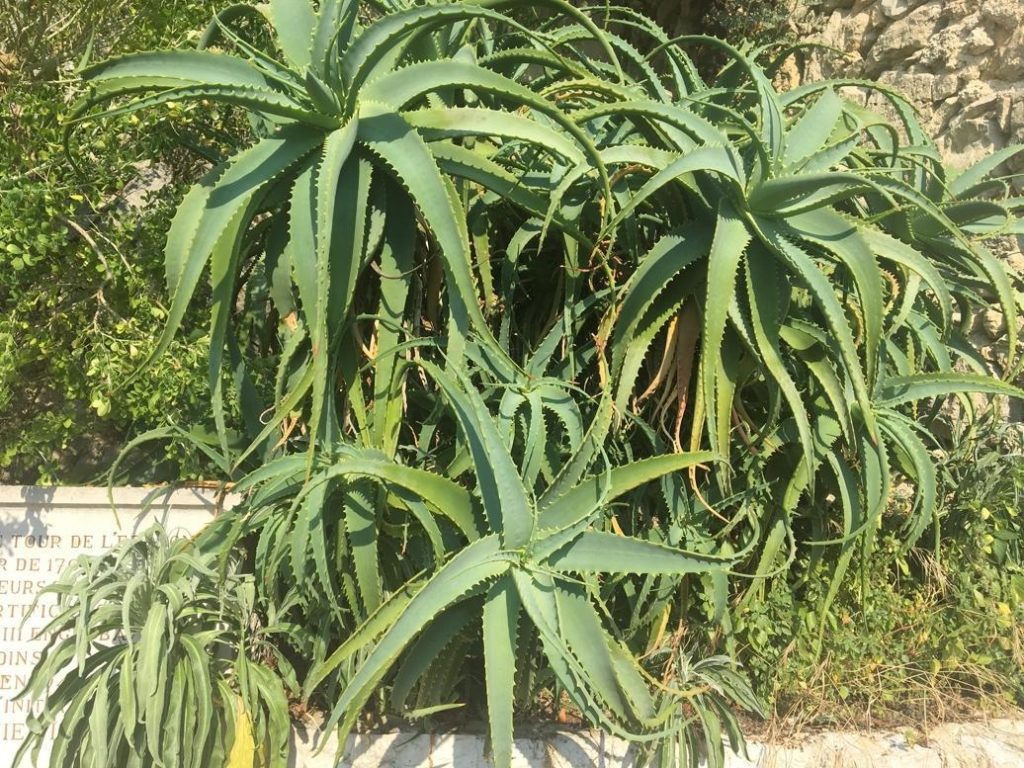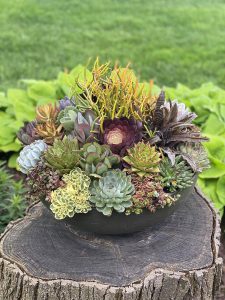by Matthew Olson
Summer is my favorite season. One of the main reasons is that I can enjoy gardening without the threat of snow, ice, and cold. Being able to grow a wide variety of plants outside adds so much joy to gardening. One group of plants that I’ve enjoyed growing over the years are succulents. Succulents are a group of plants that have the ability to store large amounts of water in their leaves. As a result, succulents are drought tolerant and very low maintenance as long as they are cared for properly. Succulents come in many shapes, colors and sizes, allowing them to be a unique addition to your garden.
In recent years succulents have become very popular houseplants. Taking care of succulents is relatively simple. Their two main requirements are good drainage and plenty of light. If you’re growing succulents inside, the best place for them is a south facing window, or under a grow light. You can purchase grow lights at many nurseries or online. During the summer, the best place for them is outdoors, but they will grow fine indoors if they have enough light.

I’ve grown many succulents over the last few years, and the easiest way to kill them is to overwater. There are several factors to determine how often you should water your succulents. The type of soil they’re grown in will have a huge effect on their water needs. Most nurseries grow their succulents in potting mix that is primarily made of peat. Peat is a type of organic matter found in bogs around Northern Minnesota and Canada. Peat is very useful because it has the strong ability to hold water, which is good for most plants, but can be a problem for succulents. One way to help your succulents is to add perlite to your potting mix. In the past, I have used a 1:1 ratio of peat and perlite when I plant succulents. The perlite is a type of volcanic rock that helps allow the soil to drain better and allow oxygen in the soil, which promotes healthy roots. You can purchase perlite at a local nursery. Succulents can thrive in regular potting soil as well as long as you are very careful to not overwater. To determine when you should water, you can stick your finger in the soil and check for moisture in the top 2-3 inches of soil. If the top few inches are dry, it should be safe to water, and if you’re not sure whether to water, it’s best to wait a couple days. Succulents can easily recover from underwatering, but overwatering is much more challenging.
Most Succulents require full sun, which means giving them as much light as you can is important, especially during winter. Succulents will let you know if they’re not getting enough light by growing very loose and leggy. Succulents tend to grow slowly. If you notice them rapidly growing in height, there’s a good chance it needs to be in a lighter location. You will also see rapid growth on succulents if they are about to flower. Flowering is usually a sign of a healthy plant. The difference between leggy growth and the growth of a flower is that flowering stems typically look different than normal growth.
If you’re like me, you’re probably always looking for ways to obtain more plants. Propagating succulents is very cheap and easy. Propagation is a term that simply means production of more plants. Many succulents can be propagated from cuttings, which involves cutting off a piece the plant and putting it in soil. The best method of propagation can vary between different species, so I recommend learning the best way to propagate whichever type of succulent you’re growing.

The majority of succulents are annuals in this part of the world. However, there are a few that can survive our harsh winters. The most common one is the perennial sedum, which is very popular and comes in many varieties. The prickly pear cactus is native to the Upper Midwest and thrives in areas with full sun and good drainage. They also have beautiful yellow flowers. One other unique succulent is the Adams needle yucca, which has beautiful spiky leaves and tall white flowers.
If you’re looking for some ideas on types of succulents to grow, I recommend checking out a local nursery. Many nurseries have a wide variety of different succulents.
Succulents are a great addition both containers and the landscape, and they can provide a striking accent that you’ll be able to enjoy throughout the summer and into the winter if you choose to overwinter them. I hope you’ll give them a try. Happy Gardening!

For more advice like this, visit our Blog Page. If you are looking into gardening services around Minnetonka, Wayzata, Excelsior, or related areas, Contact Us Today!


